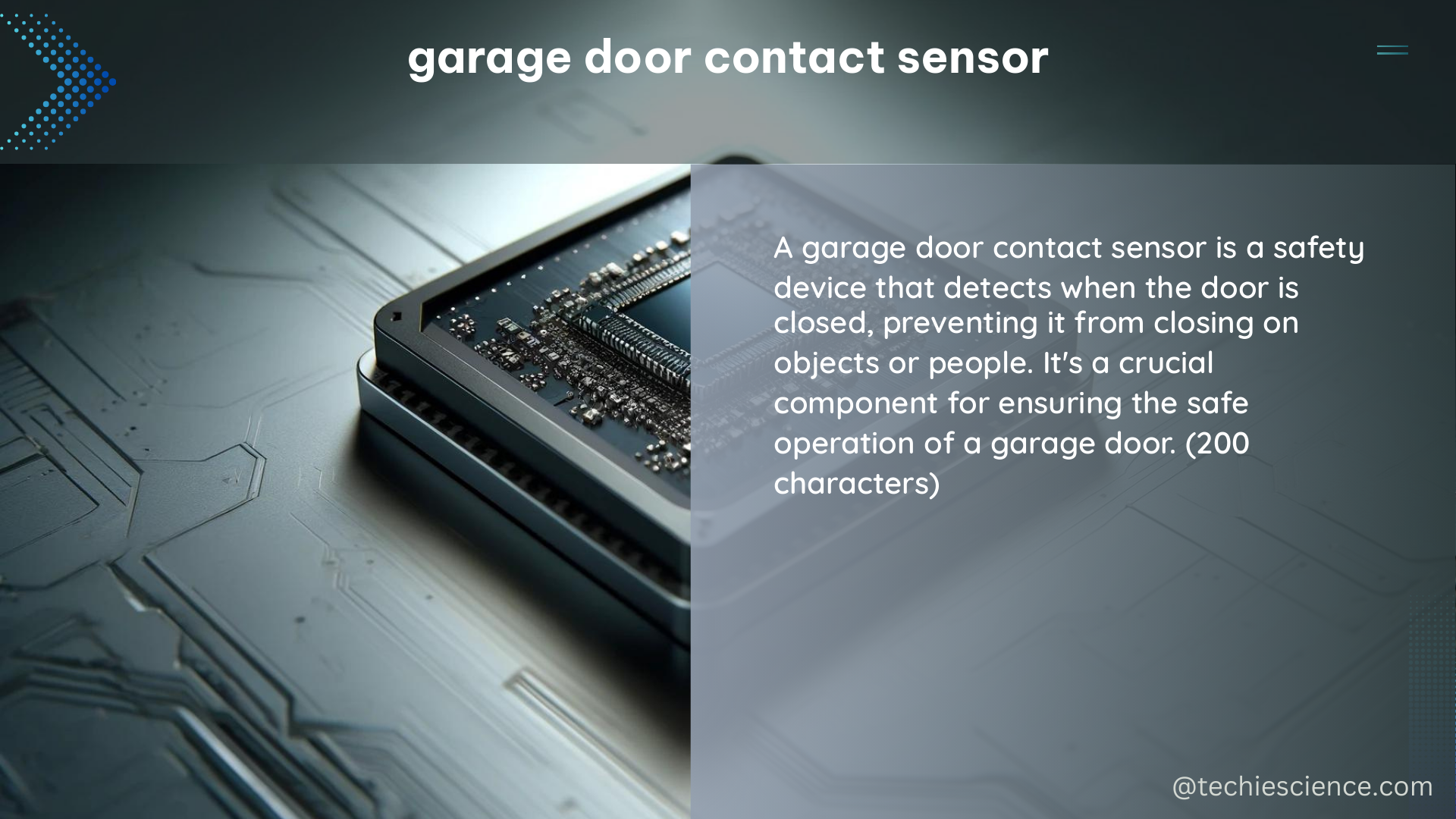The garage door contact sensor is a crucial device that provides reliable and accurate monitoring of your garage door’s opening and closing status. This sensor typically consists of two components: a magnet and a sensor, strategically positioned on the door and door frame, respectively. When the door is closed, the magnet’s proximity to the sensor triggers a detection, indicating a closed state. Conversely, when the door is open, the separation of the magnet from the sensor signals an open state.
Understanding the Technical Specifications of Garage Door Contact Sensors
Operating Range
The operating range of a garage door contact sensor refers to the distance between the sensor and magnet within which the sensor can reliably detect the magnetic field. This range can vary from a few millimeters to several centimeters, depending on the sensor’s sensitivity and design. For example, the Ecolink TILT-ZWUS Z-Wave Plus Tilt Sensor has an operating range of up to 4 inches (10 cm), while the Aeotec Recessed Door Sensor 6 can detect magnetic fields up to 1.5 inches (3.8 cm) away.
Power Supply
Garage door contact sensors can be powered by various sources, including batteries, AC power, or USB. The power supply voltage and current requirements can differ depending on the sensor’s design and features. For instance, the Chamberlain MyQ Garage Door Sensor operates on a 3V CR2032 battery, while the Iris Smart Home Contact Sensor by Lowe’s requires a 120V AC power source.
Communication Protocols
Garage door contact sensors can communicate with other devices, such as smart home hubs or smartphone apps, using various communication protocols. These protocols include Z-Wave, Zigbee, Bluetooth, and Wi-Fi. The communication range and data transfer rate can vary depending on the protocol and device compatibility. For example, Z-Wave sensors typically have a range of up to 100 feet (30 meters) in an open-air environment, while Zigbee sensors can communicate within a range of up to 328 feet (100 meters).
Environmental Specifications
Garage door contact sensors are designed to operate in various environmental conditions, such as temperature, humidity, and dust. The sensor’s operating temperature range and ingress protection (IP) rating can differ based on the design and intended use. For instance, the Honeywell 5800MINI Wireless Door/Window Sensor can operate in temperatures ranging from -4°F to 140°F (-20°C to 60°C) and has an IP20 rating, indicating protection against solid objects but not water.
DIY Approaches for Garage Door Contact Sensors

Ultrasonic Sensor and WiFi Module
One DIY approach for a garage door contact sensor is to use an ultrasonic sensor and a WiFi module. This setup can provide an alert when the garage door is left open for too long. The ultrasonic sensor can be mounted on the door frame and pointed at the door, detecting the distance to the door. When the door is open, the sensor detects the increased distance, triggering a notification. The WiFi module can then transmit this information to a smart home hub or smartphone app. This approach can be powered by a USB plug in the outlet for the garage door opener, providing a convenient and reliable power source.
Contact Sensor on Hinge or Alarm Contact
Another DIY option is to use a contact sensor on a hinge or a regular alarm contact mounted at the top of the door. These sensors can be wired or wireless, depending on the user’s preference and device compatibility. For example, the Honeywell 5800MINI Wireless Door/Window Sensor can be easily installed on the door and door frame, providing a reliable status of the garage door. Additionally, mounting the sensor on the side of the door and the magnet on the track can offer a more discreet and aesthetically pleasing installation.
Selecting the Right Garage Door Contact Sensor
When selecting a garage door contact sensor for a DIY project, it’s essential to consider the following factors:
- Technical Specifications: Carefully review the sensor’s operating range, power supply, communication protocol, and environmental specifications to ensure they meet your requirements.
- Device Compatibility: Ensure the sensor is compatible with your smart home system, hub, or smartphone app, if you plan to integrate it with other devices.
- Installation Requirements: Consider the sensor’s mounting options and the ease of installation, as well as any necessary wiring or power supply considerations.
- User Needs and Preferences: Evaluate your specific needs, such as the desired power source, communication protocol, and aesthetic preferences, to choose a sensor that aligns with your requirements.
By understanding these factors and the technical details of garage door contact sensors, DIY enthusiasts can select the right sensor for their project and enjoy a reliable and convenient solution for monitoring their garage door.
References
- Garage Door Indicator using distance sensors – Arduino Forum. https://forum.arduino.cc/t/garage-door-indicator-using-distance-sensors/591944
- Contact sensor positioning for garage door – Hubitat Community. https://community.hubitat.com/t/contact-sensor-positioning-for-garage-door/64146
- Garage Door Safety Sensors Troubleshooting – YouTube. https://www.youtube.com/watch?v=jA_uT1rnT0M
- Ecolink TILT-ZWUS Z-Wave Plus Tilt Sensor. https://www.ecolinksensors.com/products/tilt-zwus-z-wave-plus-tilt-sensor
- Aeotec Recessed Door Sensor 6. https://aeotec.com/z-wave-sensor/recessed-door-sensor-6.html
- Chamberlain MyQ Garage Door Sensor. https://www.chamberlain.com/myq-smart-garage-hub/p/MYQ-G0301
- Iris Smart Home Contact Sensor by Lowe’s. https://www.lowes.com/pd/Iris-Smart-Home-Contact-Sensor/50375542
- Honeywell 5800MINI Wireless Door/Window Sensor. https://www.security.honeywell.com/products/intrusion-detection/wireless-sensors/5800mini-wireless-door-window-sensor

The lambdageeks.com Core SME Team is a group of experienced subject matter experts from diverse scientific and technical fields including Physics, Chemistry, Technology,Electronics & Electrical Engineering, Automotive, Mechanical Engineering. Our team collaborates to create high-quality, well-researched articles on a wide range of science and technology topics for the lambdageeks.com website.
All Our Senior SME are having more than 7 Years of experience in the respective fields . They are either Working Industry Professionals or assocaited With different Universities. Refer Our Authors Page to get to know About our Core SMEs.